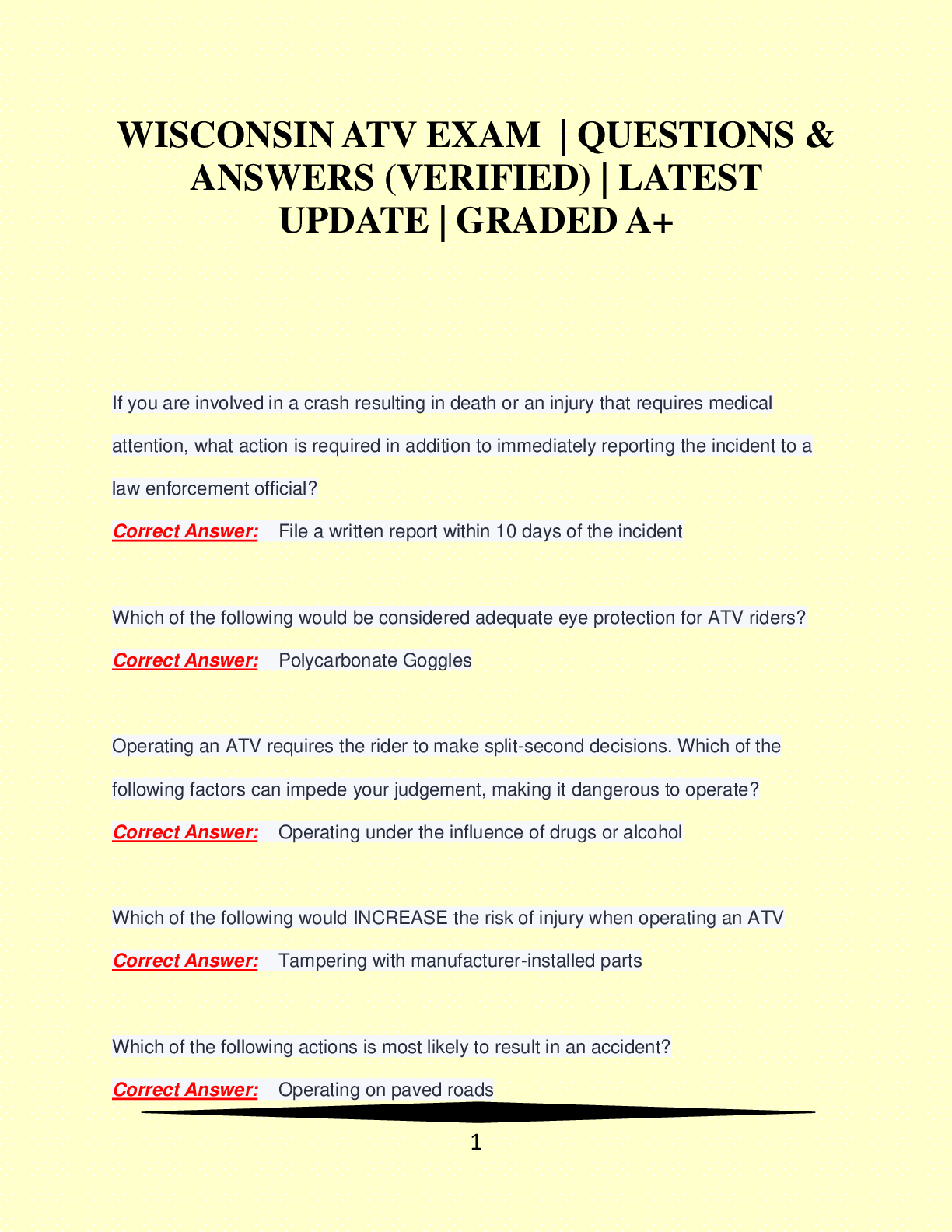
WISCONSIN CITIZENSHIP EXAM QUESTIONS & ANSWERS VERIFIED LATEST UPDATE
Surgery > QUESTIONS & ANSWERS > Surgery Week Quiz Series- Part 1 [GRADED A+] (All)
1. A 26-year-old woman is found positive for occult blood in her stool sample. A colonoscopy is performed. It shows numerous polyps, numbering more than 200, ranging in size from 1 cm - 5 cms. One p ... olyp is resected. Histologically, the polyp shows the features of tubular adenoma. There is no invasion. Molecular analysis of the patient's fibroblasts shows mutation in APC gene. What is the most likely diagnosis? A. Familial adenomatous polyp B. Juvenile polyp C. Inflammatory polyp D. Peutz-Jeghers polyp E. Lymphoid polyp 2. What is the preferred treatment for infantile intestinal obstruction due to intussusception? A. Colonoscopy B. Emergent colon resection C. Nasogastric decompression D. Barium or air enema? E. Intravenous fluids only 3. The earliest pathologic change identified in a pilonidal abscess is A. Enlarged hair follicles on normal skin? B. A foreign body C. Acute inflammatory changes D. Preexisting perianal infection E. Cyst formation 4. How is mechanical intestinal obstruction diagnosed? A. An elevated white blood cell count B. Radiologic studies? C. Clinical history and physical findings D. Upright chest x-ray E. Serum LDH level 5. What is the best description of familial polyposis? A. Autosomal recessive trait, associated with intestinal polyposis consisting of both adenomas and hamartomas B. Autosomal dominant trait, with intestinal adenomas, hamartomas, and buccal mucosal pigmentation C. Autosomal dominant trait of intestinal adenomas with a 100% risk of malignant degeneration over time D. Autosomal dominant trait with no predisposition for colon carcinoma E. Associated with intestinal adenomatosis, skull and mandibular osteomas, epidermoid cysts, and desmoid tumors 6. A 35-year-old woman presents with diarrhea in the form of 4 to 5 watery stools a day; they are mixed with blood. Diarrhea appeared 3 weeks ago, and it is accompanied with malaise and a weight loss of approximately 1 kilogram. She tells you that she has suffered from ulcerative colitis for more than 20 years; the course of her disease is characterized with multiple periods of disease attacks that are interrupted with remissions. She also tells you she has not taken any drugs for the treatment of ulcerative colitis over the past 6 months. The remainder of her personal history is unremarkable. Physical examination reveals a mildly dehydrated, average-nourished woman. Mild tenderness is present on palpation of abdomen, and the remainder of her physical examination is unremarkable. Laboratory analyses reveal an increased erythrocyte sedimentation rate (67 mm/first hour), anemia (erythrocyte count 3.5 x 10/6 erythrocytes/UL, hemoglobin level 9.6 g/dL) of sideropenic origin (serum iron level 15 ug/dL, and TIBC 450 ug/dL , with saturation of 3%; reference values are 25 - 170 ug/dL for iron, and for 200 - 450 ug/dL for TIBC). In addition, it reveals an elevated serum fibrinogen level (4.9 g/L, reference value 2.0 - 4.0 g/L), which is in accordance with previously established diagnosis of ulcerative colitis. Hypoproteinemia is also present (serum protein level is 58g/L; reference values 65 - 80 g/L). Other routine laboratory analyses reveal no abnormalities. Stool cultures do not reveal the presence of pathogenic bacteria, and parasites and their ova are not revealed in the stool. Echo sonographic examination of abdomen does not reveal any abnormalities. Colonoscopic examination is performed and an inflamed erythematous mucosa with prominent granularity and friability of the surface is noted during the entire length of the colon. About 20 centimeters above the anal margin, a mass that is mostly located in submucosa is noted. Biopsy of mucosa around the mass confirms the presence of high-grade dysplasia. No signs of dysplasia are present in other parts of the colon. What therapeutic approach would be best in the presented case? A. Proctocolectomy should be recommended B. Periodical colonoscopic control is needed C. Left hemicolectomy should be performed D. Endoscopy with biopsy should be repeated E. Medicamentous therapy should be started [Show More]
Last updated: 2 years ago
Preview 1 out of 14 pages
![Preview image of Surgery Week Quiz Series- Part 1 [GRADED A+] document](https://browseimages.nyc3.digitaloceanspaces.com/paper-images/2023/May/08/UHmaXAKq2023-05-08-03-256458ea3439541.png)
Buy this document to get the full access instantly
Instant Download Access after purchase
Buy NowInstant download
We Accept:


Surgery week 10 quiz Q # 1 of 39- 1 Points USMLE Step 2 CK Board Preparation 1. A sexually active woman with multiple partners presents with a 2-day history of red swollen left knee. On examinatio...
By geeks4geeks 2 years ago
$35
10
Can't find what you want? Try our AI powered Search
Connected school, study & course
About the document
Uploaded On
May 08, 2023
Number of pages
14
Written in
All
This document has been written for:
Uploaded
May 08, 2023
Downloads
0
Views
119
Scholarfriends.com Online Platform by Browsegrades Inc. 651N South Broad St, Middletown DE. United States.
We're available through e-mail, Twitter, Facebook, and live chat.
FAQ
Questions? Leave a message!
Copyright © Scholarfriends · High quality services·